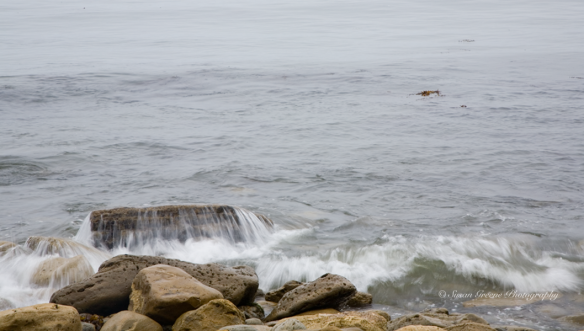 For the exploration of the last aspect of the exposure triangle, shutter speed, I slipped into my flip flops and headed to the beach – click on the highlighted elements of the other two parts of the triangle, ISO (also here ) and f-stop , if you missed them and want to catch up. The shutter controls how long the camera’s sensor is exposed to light. Shutter speed is measured by fractions of a second and the numbers represent the denominator of the fraction, a higher number is a faster speed, 500 is 1/500th of a second, which lets in less light and a smaller number is a slower speed, 13 is 1/13th of a second, which lets in more light. The numbers get lower until you get to a whole second which is denoted by 1″ and from there the numbers starts climbing again, my camera’s high end is 30″, or thirty seconds. The shutter also controls whether you will freeze an action in your scene or blur it. If the shutter is open longer, a slower shutter speed, there is more time for the camera to record motion. This is where you can get creative with your use of shutter speed. Moving water is fun to play around with. When exposed using a slower shutter speed, the water takes on a velvety look. For this photo, I used a shutter speed of 1/13.
For the exploration of the last aspect of the exposure triangle, shutter speed, I slipped into my flip flops and headed to the beach – click on the highlighted elements of the other two parts of the triangle, ISO (also here ) and f-stop , if you missed them and want to catch up. The shutter controls how long the camera’s sensor is exposed to light. Shutter speed is measured by fractions of a second and the numbers represent the denominator of the fraction, a higher number is a faster speed, 500 is 1/500th of a second, which lets in less light and a smaller number is a slower speed, 13 is 1/13th of a second, which lets in more light. The numbers get lower until you get to a whole second which is denoted by 1″ and from there the numbers starts climbing again, my camera’s high end is 30″, or thirty seconds. The shutter also controls whether you will freeze an action in your scene or blur it. If the shutter is open longer, a slower shutter speed, there is more time for the camera to record motion. This is where you can get creative with your use of shutter speed. Moving water is fun to play around with. When exposed using a slower shutter speed, the water takes on a velvety look. For this photo, I used a shutter speed of 1/13.
 Then to freeze the water and capture the drops I used a shutter speed of 1/1000.
Then to freeze the water and capture the drops I used a shutter speed of 1/1000.
 The exposure triangle comes in to play here because when you adjust one of the elements you have to compensate by adjusting one or both of the others to obtain a correct exposure. For the first photo, the shutter speed was 1/13 and the f-stop 22 with an ISO of 100. It was fairly early in the morning and beginning to get bright out (even though the sky was gray with clouds) so I had to shut my aperture down to the smallest opening possible and put the ISO down low to cut the light sensitivity of the camera in order to be able to use a slower shutter speed and capture the velvet blur of the waves’ motion. In the second photo, I raised the ISO to 200 and opened the aperture to f4 and used a shutter speed of 1/1000.
The exposure triangle comes in to play here because when you adjust one of the elements you have to compensate by adjusting one or both of the others to obtain a correct exposure. For the first photo, the shutter speed was 1/13 and the f-stop 22 with an ISO of 100. It was fairly early in the morning and beginning to get bright out (even though the sky was gray with clouds) so I had to shut my aperture down to the smallest opening possible and put the ISO down low to cut the light sensitivity of the camera in order to be able to use a slower shutter speed and capture the velvet blur of the waves’ motion. In the second photo, I raised the ISO to 200 and opened the aperture to f4 and used a shutter speed of 1/1000.
An egret flew in for a look about and stayed for awhile as I snapped away at the yellow-footed beauty. First, I wanted to catch it with detail and freeze any movement it might make and used a shutter speed of 1/125.
 Then, I wanted to capture the movement of the bird walking along the shore and switched the shutter to 1/13.
Then, I wanted to capture the movement of the bird walking along the shore and switched the shutter to 1/13.
 Standing perpendicular to the waves is a way to be able to capture the movement. A 1/6 shutter speed was the setting for this one, giving the water a soft, smooth appearance.
Standing perpendicular to the waves is a way to be able to capture the movement. A 1/6 shutter speed was the setting for this one, giving the water a soft, smooth appearance.
 At a shutter speed of 1/500, you can see how the details in the water are distinguishable and the wave is frozen in mid-air.
At a shutter speed of 1/500, you can see how the details in the water are distinguishable and the wave is frozen in mid-air.
 If your shutter speed is too low and you don’t have a tripod, you may end up with a blurry picture due to camera shake. In general, for hand-held photography use a shutter speed at or higher than the focal length of your lens, for example if the focal length of your lens is 100mm, you want to use shutter speeds of 100 or greater. The longer the focal length the more susceptible the camera is to camera shake. There may be times that you just have to use a tripod to get the shot.
If your shutter speed is too low and you don’t have a tripod, you may end up with a blurry picture due to camera shake. In general, for hand-held photography use a shutter speed at or higher than the focal length of your lens, for example if the focal length of your lens is 100mm, you want to use shutter speeds of 100 or greater. The longer the focal length the more susceptible the camera is to camera shake. There may be times that you just have to use a tripod to get the shot.
If you are interested in further exploration of capturing motion check out this previous post.
With an eye for action this week,
~ Susan
































